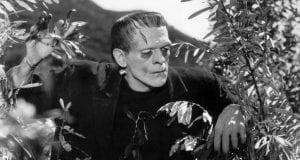Welcome back.
Today we will be discussing one of the most interesting projects we’ve ever done in PLP. And by interesting I mean a total roller coaster of emotions and motivation. You will see what I mean as you read through this post, which is going to take you through what we accomplished in our unit focused on Horror.

As with every unit in PLP, we were given a driving question at the beginning. This unit would get us to think about society and how we portray issues and ideals through filmmaking, specifically horror movies. The driving question was:
“Why is horror such an effective way to reflect and comment on our society?”
We would be thinking about this question throughout the unit, and relating everything we do back to this question. And the first thing we did was read one of the most famous horror stories of all time, Mary Shelley’s Frankenstein.

This book was not at all what I was expecting. It was way more deep and meaningful than I thought it would be, which I suppose is why it’s so well known. The story itself was really amazing, but personally it was a little slow paced for my tastes. Frankenstein was intended to get our minds spinning about who the real monster is in the story. Is it the creature? Doctor Frankenstein? Society as a whole? Before reading the book, if I had to pick, I would obviously pick the creature. That is because of the creatures appearance: big, ugly, and just plain old monstrous. But that is exactly what the book points out. As society, we are too quick to judge based off of appearance, causing us to be the real monsters. The creature in the story was seen as an outcast, a criminal, and a monster just because of the way he looked, yet he only acted in curiosity at first. But by the end, he was fed up and enraged so much that he sought out revenge on the people who ruined his chance at life. The book exploits our negative tendencies to judges someone, which is something that happens way too often even in today’s society.
My biggest takeaway from this book is that, in fact, horror can be used as an effective way to reflect on our society. I hadn’t put much thought into it before, but this book opened my eyes to the possibilities of horror storytelling. And I would see these possibilities later on in the unit.

Now that we have studied some horror in written form, we moved onto horror filmmaking, which would lead us right into our final product. At this point, we have studied Mary Shelley’s Frankenstein, and looked into who or what the real monster was. So now, to take that further, we watched 3 films that would make us wrestle with that topic further. I wrote a post on each one we watched, so you can check the posts out for further details. The three movies we watched in class were Halloween (1978), Gods and Monsters, and Get Out. Each movie quite different from the last, which made for some interesting research and inquiries. Read my posts for more info.
What I learned from these films was that horror has the potential to bring out our true nature, the nature that’s usually hidden deep inside of us. We discussed in class something I found quite interesting, which is the fact that horror is a popular genre because it shows us things we’re not supposed to see. People getting stabbed, choked, cut up by chainsaw, and just brutally murdered in general are things we know we shouldn’t watch, yet we can’t take our eyes off the screen. Horror is a chance for people to watch gruesome scenes without it happening to them. The horror genre entertains and gives the viewers an escape from their usually mundane reality. Horror is not a genre I’m interested in at all, I’d rather stick to not seeing death by chainsaws if I can help it.
We took a 3 day field school to Seattle to have a closer look at the effects of horror by visiting the MoPOP. It’s a popular museum of pop culture located in Seattle, and it has an exceptional horror exhibit, amongst other things. While we were in the exhibit, we were closely studying the short documentary style videos they had playing. The videos talked about each of the most famous horror movies and why they are so popular. We took lots of notes, because we were brainstorming for our own horror movie. Except, since we weren’t a full scale movie crew, our movie would only be about 25 minutes. And so, that’s what our final product of the horror unit would be.

Our Task:
Write, script, storyboard, film, edit, and produce our own 25 minute horror film as an entire class. The story must have a comment on today’s society that is well thought out, and can be understood from a viewers perspective through the scenes we film.
That was the main idea of the film. How it would actually come to life is a long process. In Seattle, we decided on roles. The director and producer would be chosen by the teachers after an interview process. Then they would help the teachers to put the rest of the class in roles based on their skillset. Me and Alex ended up being Co-Producers, and Adam the director. Over the course of that field school, we came up with the story treatment as a class, and also put everyone into a role that a normal movie crew would have.
KEY CREATIVE TEAM
Producer – Spencer
Director – Willa
Screenwriter – Claire
PRODUCTION DEPARTMENT
Line Producer – Ethan
Production Manager – (Sam)
First Assistant Director – Isobel
Second assistant Director – Alex
Craft Services – assigned as needed
SCRIPT DEPARTMENT
Script Editor – Izzy
Script Co-ordinator – Mimi
LOCATION DEPARTMENT
Location Manager – Isobel
Location Assistant – Claire
CAMERA DEPARTMENT
Director of Photography – Sam
Camera Operator – Sam
SOUND DEPARTMENT
Production Sound Mixer – Robbie
Boom Operator – (Alex)
GRIP DEPARTMENT
Key Grip – Calum
ART DEPARTMENT
Production Designer – Sofia
Art Director – Chiara
Props Master – Mimi
HAIR and MAKE-UP DEPARTMENT
Make-up Artist – Parker
WARDROBE DEPARTMENT
Costumer Designer – Hannah
Costume Assistant – Sofia
POST PRODUCTION
Post-production Supervisor – Alex
Editor – Ryan
Assistant Editor – Adam
Visual Effects Supervisor – Robbie
Music Supervisor – Isobel
Over the course of the next few weeks, we would be going through lots and lots of planning, prep and eventually, actual filming. I think I speak for my whole class when I say it was a bumpy road all the way to the finish line. To set the scene: we had about one month to create this movie, once we were finished with all our other work. We started off by getting the script team to write a first draft of the script, while the others were making lists of potential props and getting inventory on camera gear and lights. Once the first draft of the script was done, we all critiques it as a class, with the help of the teachers. And we all had a lot of critique. So, the script writers went back to work with our critique in mind. This went on a few more times, which I believe was the reason our film never actually finished. Whoops, I already spoiled the surprise, we ended up running out of time, and not finishing all our filming. Our deadline for filming was the day before Christmas break, and that itself was an extended date. But nevertheless, it just wasn’t enough time.

There were a few reasons why we lost time, reasons I won’t get into because in the bigger picture, they really aren’t important. What is important, however, is what we learned. Because even though we failed, we still learned a lot. I still learned a lot. One of the biggest learning points for me came from a personal failure during the movie process. As I said before, I was a co-producer, but not for the whole time. Near the end, me, Alex and Adam all stepped down from our positions because we weren’t doing our jobs to the standards expected from our peers and our teachers. This I agreed with. I had not been a producer for the entire time I was supposed to be a producer. This taught me that if I wanted a role with high responsibility and power, that I would have to be responsible. And at that time, I wasn’t doing that. It could be argued that it was because I was concussed at the time, but that’s not important. LEARNING is importanter.
Since I was no longer producer, I stepped down and accepted the role Director of Photography. This role ended up being way more fitting for me personally, and I’m glad that I got the opportunity. Even in the midst of failure, I adapted to my situation and learned from it. DOP was way more tuned to my skills, and I wanted to learn as much as I can about filming while I had the chance. This is because I am planning on pursuing film school as my post secondary education, so I was more inclined to do my best in this position as I was in the role as a producer. So, I made the best of the situation and worked as hard as I could.

The gear I was using
I did actually learn so much from this, camera wise and bigger picture wise. I learned more technical knowledge about using my camera for filming movies, like how different lenses portray different moods, and how important camera placement is. I also tried my best to tackle the difficult nature of showing a story in written words through the lens of a camera lens, which was harder than I had pictured. Bigger picture wise, we failed, but we all learned so much. I personally learned the value and importance of communication and organization. Ironically, I learned that through a lack of communication and organization. Some days, we were all prepared, and other days everything went wrong that could have gone wrong.
But overall, it was a fun project. A stressful and taxing project, but a fun one. If I were to do it again, I’d get more time, and focus on doing all the work possible before we even pick up a camera. I have been talking a lot, so now is the time where you can watch the result of all our blood, sweat and tears. We made a trailer with the footage we filmed, since we just didn’t have enough to complete our movie.
And that is that. Thank you for reading all this, I feel like it was an amazing learning experience. I don’t think I would have said that during the project, but I am wiser now because of this, so I know better.
thats all,
See you